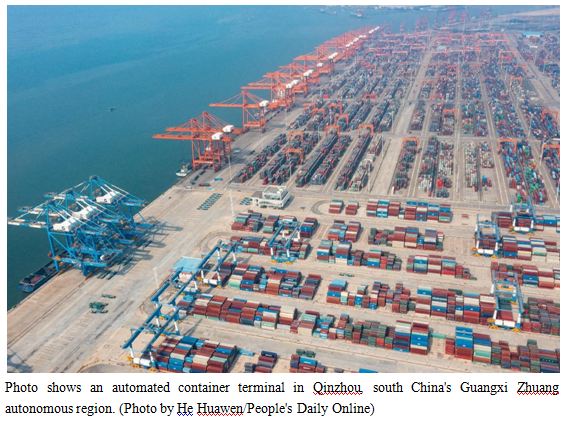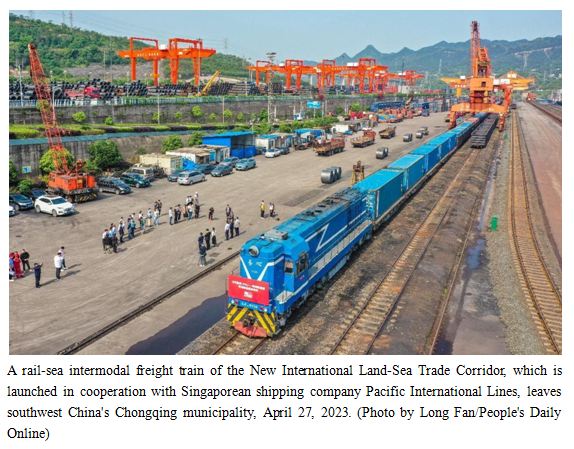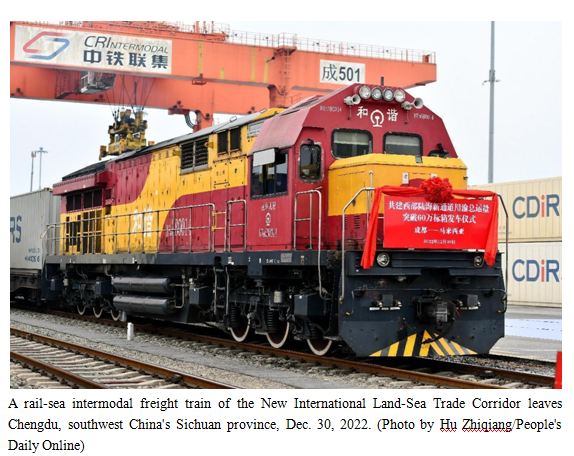By Liu Hui, People’s Daily
A rail-sea intermodal freight train recently departed from southwest China’s Chongqing municipality, running along the New International Land-Sea Trade Corridor for Qinzhou, south China’s Guangxi Zhuang autonomous region. The train carried 100 containers of automobiles, motorcycles and engines, which would be later shipped to destinations in Southeast Asia via Qinzhou Port.
During the Chinese Lunar New Year period this year, the year-on-year growth in the number of trains running along the New International Land-Sea Trade Corridor set a new record.
The New International Land-Sea Trade Corridor is a new channel of international trade jointly established by regions in western China and ASEAN members.
In September 2017, the first train of a regular sea-rail transit route linking China and Singapore, the former version of the New International Land-Sea Trade Corridor, departed from Chongqing.
The southward route took Chongqing as its logistic and operational center and involved key nodes including Guangxi, Guizhou, Gansu, Qinghai and other provincial-level regions in western China. Sending cargo to Southeast Asia and the rest of the world via China’s Guangxi, the rail-sea intermodal route gradually became the most convenient export channel in western China.
Today, the New International Land-Sea Trade Corridor has constantly optimized its services, and its network now extends to ports in Singapore, Bangkok of Thailand, Ho Chi Minh City of Vietnam and other ASEAN regions.
The implementation of the Regional Comprehensive Economic Partnership (RCEP) has further accelerated regional economic integration and is driving the demand for international logistics. The corridor has provided diversified choices for merchants.
“With the land-sea route, cargos from Brunei can be shipped to Qinzhou Port via Singapore and then be sent to China’s Yunnan, Sichuan and Chongqing by train, which is very convenient, ” said a merchant surnamed Zheng from Brunei who sells Brunei’s shrimp chips and coffee products to the Chinese market and brings Chinese orah mandarin oranges to ASEAN countries.
“I can save both time and money to ship my products via this route,” Zheng told People’s Daily.
Trade between western China and ASEAN members used to rely on the ports in eastern China, said Li Mingjiang, Associate Professor at S. Rajaratnam School of International Studies, Nanyang Technological University.
The New International Land-Sea Trade Corridor has reduced shipping distance and thus lowered cost, and helps strengthen the relations between regions in China’s western regions and ASEAN countries in trade, investment and logistics, Li noted.
As one of the largest shipping companies in Southeast Asia, Pacific International Lines (PIL) of Singapore runs two routes along the New International Land-Sea Trade Corridor.
According to the executive chairman of the company Teo Siong Seng, TIL ships durians, coconuts, mangoes, bananas and other fruits from Southeast Asia to regions across China via Qinzhou every year during the harvest season.
The land-sea route not only builds a better transport network, but also strengthens economic and trade cooperation between China and other countries. It injects increasing momentum for foreign enterprises to deepen trade cooperation with China.
Over recent years, TIL’s business volume in Guangxi has been on a rapid increase. Teo Siong Seng told People’s Daily that industrial raw materials, fertilizers, and minerals produced in southwest China are being shipped along the corridor to Southeast Asia and other countries and regions along the Belt and Road, including products with high value-added products such as auto parts and solar panels, which has significantly promoted local economic development.
The New International Land-Sea Trade Corridor has presented new opportunities of China-ASEAN cooperation to more and more companies in Southeast Asia.
As the China-Laos Railway and other connectivity projects started operation, Zheng is planning to bring more ASEAN products to China and take them to Europe through China-Europe freight trains.
The Bruneian businessman said the implementation of the RCEP has significantly facilitated customs clearance, which led to a big rise in his company’s exports.
“Better connectivity means more business opportunities,” Zheng said.



















